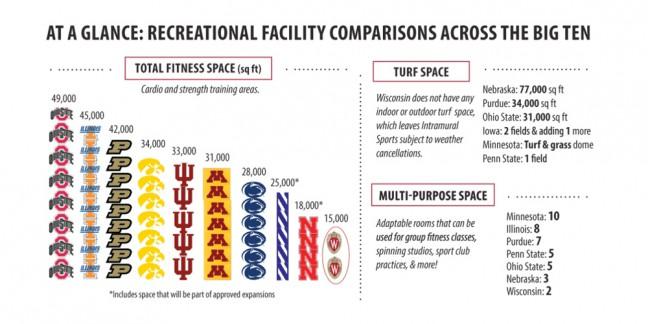After a draft referendum for Recreational Sports’ master plan was passed by a branch of University of Wisconsin’s student government, the organization held a campus forum Wednesday to gain student feedback.
The master plan entails changes to the Southeast Recreational Facility, the Natatorium, Near West Fields and Near East Fields. The plan does not include the Nielsen Tennis Stadium or the University Bay Fields. However, alternate funding will be sought to improve the quality of the facilities not included in the plan, and there is already one donor very interested in helping, Rec Sports director John Horn said.
At the forum, students responded positively to increases in the number of windows at each facility, weight room space and the addition of indoor turf fields. Students said the fitness rooms at the SERF are always too crowded and that teams currently have to pay for indoor space, which was bothersome.


Alyssa Studer, a women’s club soccer player, said she was concerned with the lack of attention given to informal multi-activity courts in the plan because only one was shown in the layout at the Natatorium and the SERF.
Horn said the current layout was tentative and with further feedback and a better idea of available funding, adjustments to specifics would be more carefully assessed. He added there would likely be additional courts turned into multi-activity courts.
Charlie Hartley, a member of the men’s club lacrosse team, expressed concern over the timeline for the master plan.
UW competitive sports coordinator Ashley Lax said the timeline did not have much flexibility. It is possible the outdoor areas will come sooner, but construction on the buildings will not start for another four years, Lax said.
Ian Malmstadt, leader of Badgers for Recreational Reform, said the estimated completion of the entire project is 2021. However, the SERF could be open as soon as 2019.
Will Simson, a member of the men’s club lacrosse team, asked why current students should pay segregated fees for something that will not be implemented by the time they graduate.
Segregated fees will increase in the coming years regardless of whether the master plan is implemented or not, Lax said. The current proposal is that students would not pay additional fees for the new buildings until they are built, she said.
“Students will not be paying for something that’s not there,” Lax said.
Lax said Rec Sports are aware the construction will cause at least one facility to go down at some point, so they will find a way to combat the loss of space. An option is to make plans for nearby places to transfer equipment so students may continue to exercise close to them, she said.
The Student Services Finance Committee will vote on the final draft of the referendum before the master plan is put to a vote in front of the entire student body in early March.
[Design renderings via Rec Sports Master Plan WordPress blog]













